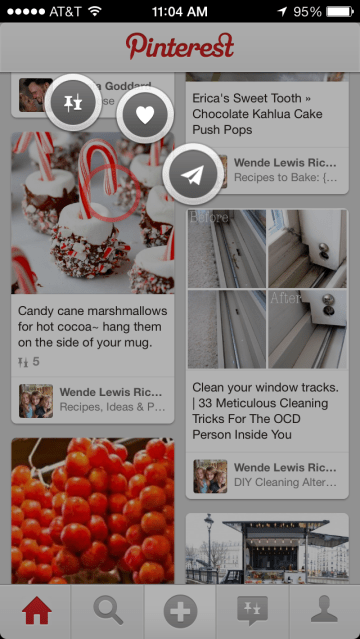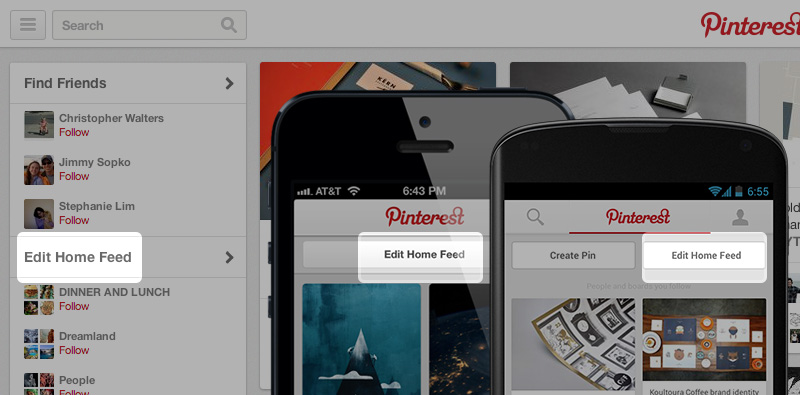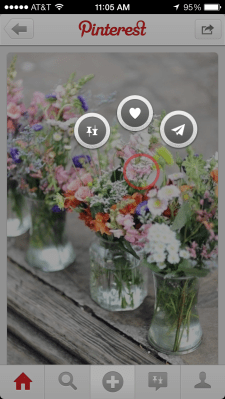Say what you want about Path and their previous transgressions, but it’s great to see other mobile applications borrowing the interface and animations Path popularized through its stellar design. Tumblr was one of the first big name apps to adopt Path-like pop-out animations (round circles that appear when tapping to create a new post), and now, Pinterest is doing the same in an effort to make repinning, favoriting, and sharing pins easier for users.
In an update to its iOS application, Pinterest has introduced a new interface design where users can press and hold on a pin in their feed, in order to make rounded action buttons appear. However, unlike on Path or Tumblr, Pinterest’s buttons don’t stay visible after you lift your finger – instead you have to slide your finger from where you originally pressed the pin, over to the button you want to use.
Unfortunately, these new animations only show up on items others have pinned, that you now want to engage with in some way. Meanwhile, the process for adding a pin of your own is relatively unchanged – you push the bottom center button and choose what you want to pin from a standard menu offering options like “website,” “camera,” “clipboard” or just “cancel.”
 It’s almost as if Pinterest is experimenting with the idea of new interactions here, rather than rolling out a major interface upgrade all at once. By forcing users to press and hold, too, the new animations arrive as optional way of interacting with pins. However, for those mainstream users who are slow to change their ways (i.e., the majority of Pinterest’s user base), they can still pin and share and like from more obvious action buttons on an individual pin’s page itself.
It’s almost as if Pinterest is experimenting with the idea of new interactions here, rather than rolling out a major interface upgrade all at once. By forcing users to press and hold, too, the new animations arrive as optional way of interacting with pins. However, for those mainstream users who are slow to change their ways (i.e., the majority of Pinterest’s user base), they can still pin and share and like from more obvious action buttons on an individual pin’s page itself.
Pinterest’s mobile applications have seen other slow but steady improvements like this over the course of the year, with updates earlier this month which brought pin sharing to iPad and pin search, for example, plus previous updates which finally solved the problem of being able to pin websites, and the addition of things like enhanced pins with pricing info and availability (oh yes!), upgrades to group pin boards, push notifications, and new discovery mechanisms.
Pinterest Moves Toward A Business Model
Pinterest doesn’t make a lot of buzz about its mobile app updates, generally speaking, but it does when it matters. For instance, it’s worth noting that Pinterest’s new pin suggestion feature is launching on mobile at the same time as web.
In fact, the Pinterest app’s update text in iTunes says this feature is actually included with the latest update, noting that users can now “tap edit Home Feed to easily add and remove stuff from their home feed (iPhone).” Oddly, I’m not yet seeing the option appear following the app update, but your mileage may vary. Pinterest said this would arrive in over the next few weeks, so it could be a staged rollout. (Update: Pinterest confirms this is the case.)

While new animations are enjoyable, this forthcoming feature update is the real deal.
Pinterest recently announced it would begin tracking user activity including those who utilize its “Pin It” button on external websites, while simultaneously allowing users to opt-out. The move is meant to personalize the experience for visitors with better pin and board recommendations, but it also serves as a way for Pinterest’s business customers to target users by pointing them to their own relevant user accounts and boards. In the example Pinterest had provided, someone pinning a lot of vegetarian recipes from around the web would be introduced to other popular boards on the site. This could enable a whole new way for interest-based social advertising to exist outside of Facebook’s likes and Twitter’s own attempts at building the interest graph.
This startup is a great example of the kind of mainstream and accessible technology which is still largely lacking in the industry at present. The service presents itself to end users as an engaging time sink, where they can find things that matter to them – “them” being mainly female users who are pinning and sharing things related to fashion, children and family, recipes and cooking, home decor and design, arts and crafts and DIY, and other topics which everyday people care about – and yes, still generally, everyday women.
As pinners’ involvement with the service grew, businesses began to feel the effects – many e-commerce sites now point to Pinterest as being among the top referral mechanisms from social media services.
Pinterest is no small potatoes, either – it had grown to some 50 million monthly uniques by the time of its $200 million Series D. That’s smaller than Twitter, which has some 200+ monthly actives, but it’s growing still.
